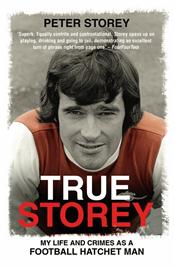 Growing up in the seventies, my football education came from my dad’s allegiance to The Arsenal and through me discovering my own team, Fulham. The game was a very different beast then. Football on the television consisted of highlights on a Saturday night with ‘Match of the Day’ and Sunday afternoons with ‘The Big Match’. Live football? Well that was one game a season, when the FA Cup Final was shown. Teams wore simple kits in traditional colours without a hint of advertising and played on pitches that varied between sand strewn mud-heaps and bare, rock hard surfaces. It was a time when football was a much more physical game and every First Division team had their ‘hard-man’. Chelsea had Ron Harris, there was Tommy Smith at Liverpool and Norman Hunter at Leeds United, whilst Arsenal had Peter Storey. So in reading “True Storey: My Life and Crimes as a Football Hatchet Man” I knew the footballing background against which the story is set.
Growing up in the seventies, my football education came from my dad’s allegiance to The Arsenal and through me discovering my own team, Fulham. The game was a very different beast then. Football on the television consisted of highlights on a Saturday night with ‘Match of the Day’ and Sunday afternoons with ‘The Big Match’. Live football? Well that was one game a season, when the FA Cup Final was shown. Teams wore simple kits in traditional colours without a hint of advertising and played on pitches that varied between sand strewn mud-heaps and bare, rock hard surfaces. It was a time when football was a much more physical game and every First Division team had their ‘hard-man’. Chelsea had Ron Harris, there was Tommy Smith at Liverpool and Norman Hunter at Leeds United, whilst Arsenal had Peter Storey. So in reading “True Storey: My Life and Crimes as a Football Hatchet Man” I knew the footballing background against which the story is set.
One immediate impression about the book is that the 224 pages (Mainstream Publishing 2011 Edition) consist of 23 chapters and an introduction. This for me meant that whilst reading, the book moved on at quite a pace as each chapter was relatively short, precise and punchy, making it a quick read. Overall the style is conversational with some humour, but is essentially forthright, blunt and to the point.
The Introduction provides Storey’s raison d’être for the book in that he wanted to “…explain the ‘madness’ (the seedy side of life after football) for the first time…”. The book is his chance to put straight the “…many lies and half-truths peddled as ‘fact’ relating to the crime which blighted (his) life…” Following the Introduction, Storey’s life is told from growing up in 1950’s Britain in Aldershot, to present day life in South-West France.
The reader is eased into Peter Storey’s tale with his early playing days and his progress through the representative sides of Aldershot & Farnborough Schools FA, London Schools and England Schoolboys, with his passion and desire to be a professional evident. Having left school at the age of 15, he then signed for Arsenal in 1961, “…the best club in the football world…” However, at that time North London rivals Tottenham were the Kings of English football having just become the first club in the Twentieth Century to do the Double.
Peter settled into the youth team playing in the South East Counties League playing alongside Peter Simpson and Jon Sammels, who like Storey went on to establish themselves in the first team. By the 1962/63 season, he progressed to the A team (third team) playing in the Metropolitan League and had signed a professional contract. Storey’s frustrations at not progressing as quickly into the first team is evident, but in the 1964/65 season he travelled as first reserve for an FA Cup 4th Round fixture at Peterborough United and was now playing in the Reserves. Off the pitch, life too was changing for him as he shared houses with Jon Sammels and Terry Neil, where trips to the laundrette and a lack of food provide some amusing tales about the bachelor lives of the young Gunners players.
The 1965/66 season saw Peter Storey make his first team debut for the Gunners on 30th October 1965 at Filbert Street against Leicester City. Arsenal lost 3-1 and Storey made his mark, when he “…coldly barged Sinclair into touch with the ball long departed…” – Peter Storey had arrived. Billy Wright the Wolves and England legend was manager at the time and Storey offers an insight into a club not happy under Wright’s leadership. It was a wretched season for the Gunners and with six games to go they were in serious relegation trouble. However, they did survive, but it had an effect on the Highbury faithful. So much so that the lowest attendance for a competitive game at Highbury was recorded that season, when on 5th May 1966, just 4,554 turned up to watch the Division One fixture against Leeds United. Inevitably at the end of the season Wright was sacked.
Given this background, perhaps it was understandable Storey observed that at Arsenal, “…concern for the club and interest in the new manager took precedence over the World Cup…” as the 1966/67 dawned. Although, he did reflect that he noticed, “…teams in the First Division getting a lot more organised, much more professional…” Bertie Mee was appointed Manager along with Dave Sexton as First Team Coach, an appointment Storey saw as vital since Mee “…didn’t have a clue about tactics…” Sexton moved on in October 1967 to manage Chelsea and in came Don Howe to begin a historic period and partnership for the Gunners.
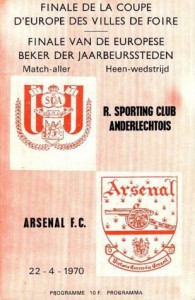 In 1968 and 1969 the Gunners made it to Wembley to the League Cup Final. Despite losing both, 1-0 against Leeds United in 1968 and 3-1 against Swindon Town in 1969, the good times at Highbury were about to bloom. In 1969/70 Arsenal took part in the Fairs Cup (now Europa League) and overcame Anderlecht 4-3 over two-legs in the Final. Even better was to come the following season. Given the historic nature of Arsenal doing the Double, Storey does devote two chapters to the achievements of that memorable season for the Gunners. However, it wasn’t all glory, glory as Storey saw it.
In 1968 and 1969 the Gunners made it to Wembley to the League Cup Final. Despite losing both, 1-0 against Leeds United in 1968 and 3-1 against Swindon Town in 1969, the good times at Highbury were about to bloom. In 1969/70 Arsenal took part in the Fairs Cup (now Europa League) and overcame Anderlecht 4-3 over two-legs in the Final. Even better was to come the following season. Given the historic nature of Arsenal doing the Double, Storey does devote two chapters to the achievements of that memorable season for the Gunners. However, it wasn’t all glory, glory as Storey saw it.
On the Official Arsenal Website, there is a feature on the ‘50 Greatest Arsenal Players’. Peter Storey completes the list at Number 50, a testament to his contribution to the club and regard by the fans. The site outlined his contribution to the Gunners history with the following:
If Peter Storey hadn’t held his nerve, Arsenal would not have made history in 1971. It’s as simple as that. Storey was a vital – if unsung – member of Bertie Mee’s Double squad and his crucial contribution came in March of that year as Arsenal stared defeat in the face at their FA Cup Semi-Final against Stoke City at Hillsborough. Storey had already halved a two-goal deficit with a rasping second-half drive but Stoke looked set to seal a 2-1 victory, and book their place at Wembley, before Arsenal were awarded a stoppage-time penalty for a handball on the goal line. The yellow-shirted Gunners leapt with joy – but not Storey. He had the unenviable task of beating England legend Gordon Banks from 12 yards to keep Arsenal’s Double dream alive. Storey saw Banks go right and slotted the ball low to the keeper’s left, cool as you like. Arsenal went on to win the replay, lift the Cup and complete the Double.
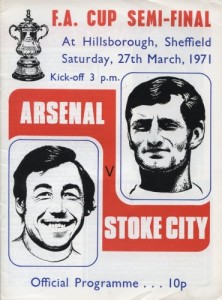
 Storey recalls the highs of those events in Chapter Twelve, (“I’ll always have Sheffield”), but Stoke also had unhappy memories later that season when Storey was injured in the fixture against the Potters at Highbury. It meant he missed the title decider at Tottenham and he admits he felt something of an outsider as the team celebrated the title win and observed that he, “…knew a little of the emotional pain and bitter disappointment Jimmy Greaves experienced when he was injured during the World Cup and watched as his replacement Geoff Hurst became a national hero…”. Still carrying the injury, missing the Cup Final looked inevitable and Storey recalls an intriguing episode in which he believes Bertie Mee tried to ensure he missed the game. Peter Storey having declared himself fit was then put through his paces by the manager which Storey saw as an “…unbelievably gruelling fitness test…” However, Storey came through the test, but on the day in the Final against Liverpool he lasted about an hour before limping off.
Storey recalls the highs of those events in Chapter Twelve, (“I’ll always have Sheffield”), but Stoke also had unhappy memories later that season when Storey was injured in the fixture against the Potters at Highbury. It meant he missed the title decider at Tottenham and he admits he felt something of an outsider as the team celebrated the title win and observed that he, “…knew a little of the emotional pain and bitter disappointment Jimmy Greaves experienced when he was injured during the World Cup and watched as his replacement Geoff Hurst became a national hero…”. Still carrying the injury, missing the Cup Final looked inevitable and Storey recalls an intriguing episode in which he believes Bertie Mee tried to ensure he missed the game. Peter Storey having declared himself fit was then put through his paces by the manager which Storey saw as an “…unbelievably gruelling fitness test…” However, Storey came through the test, but on the day in the Final against Liverpool he lasted about an hour before limping off.
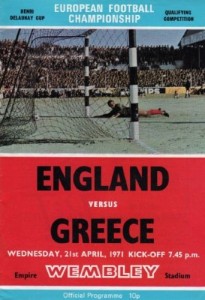 Success at club level brought Peter Storey international recognition and his first cap came in 1971 in a 3-0 win at Wembley against Greece. Sir Alf Ramsey recognised the versatility of the Arsenal man and in winning 19 caps he played at both right and left back and in midfield for his country. Not bad for somebody who many thought was just an “assassin and a thug…”
Success at club level brought Peter Storey international recognition and his first cap came in 1971 in a 3-0 win at Wembley against Greece. Sir Alf Ramsey recognised the versatility of the Arsenal man and in winning 19 caps he played at both right and left back and in midfield for his country. Not bad for somebody who many thought was just an “assassin and a thug…”
That Double winning season proved to be the peak for that Arsenal side. It came as a shock when Don Howe resigned to manage WBA at the beginning of the 1971/72 season. Storey couldn’t understand why the Coach had left when there was the challenge of the European Cup and the chance to build a legacy at Arsenal existed. Whilst the departure of Howe didn’t have an immediate effect, Storey felt that there was a gradual decline in standards, discipline and direction which meant the Gunners never hit the heights of the Double winning season. Arsenal returned to Wembley for the 1972 FA Cup Final, but lost out to Leeds United 1-0. 1972/73 the Gunners finished runners-up to Liverpool for the title. However, the following season they finished 10th. 1974/75 was even worse with Arsenal bottom during October 1974 before finishing 16th and they finished 17th in 1975/76. Storey started that season in the reserves and despite some first team appearances, was suspended by the club in March after a row with Bertie Mee. Terry Neil came in as the new Gunners boss in 1976/77 and offered a way back for Storey, who by his own admission was “…on the piss and out of condition…” To his credit Storey battled back to fitness but as the season went on he was honest enough to acknowledge that he “…was drinking and not really interested in playing for Arsenal any longer…” In March 1977 Peter Storey was transferred to Fulham, where he teamed up with Bobby Moore and George Best. He helped save the Cottagers from relegation and started the 1977/78 season at Craven Cottage. However, his heart wasn’t really in it and he played his last game as a professional footballer on Saturday 10th September 1977 ironically away at Spurs.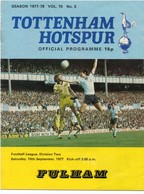
In recounting the episodes regarding his life after football, Peter Storey is incredibly candid. Indeed this extends to his relationships and marriages, where Storey recognises that his selfish and vain life-style were major factors in their failure. Storey doesn’t hide his brushes with the law or try to blame anybody else. He admits that he missed the buzz that football had provided him with and was “…attracted to the brash, flash lifestyle enjoyed by smartly dressed thieves…the way they always seemed to have a pretty girl on one arm, a pocketful of ready cash and plenty of time to indulge themselves…”. Storey pinpoints the buying of the Jolly Farmers in the summer of 1975 as the beginning of the end. Storey honestly admits, “…the decline, when it came, was relatively swift, brutal and mostly my own fault…and (I) found solace in a bottle…” The spiral downwards included, spells in jail for smuggling pornographic videos and conspiracy to counterfeit gold half-sovereigns, a suspended sentence for running a brothel and conviction for selling cars which were on hire-purchase. Reading these final chapters of the book is a shocking, yet sobering experience, that illustrates how easily life can descend into chaos.
It is a book which provides a great insight into a genuine Gunners legend, honestly detailing the highs of his playing career and the murky lows of crime and prison in life after football. However, Storey was lucky that he had people to help and support him to emerge the other side and now lives a contented life in France with wife Daniele. Storey closes by telling with obvious pride about the three boys he has and the simple enjoyment that a few beers shared with his sons and his father can bring. The hatchet man has put down his axe and seems at peace with the world.
 Glory and Despair is a pictorial celebration of the World Cup that takes us on a spellbinding journey, from the inaugural tournament in 1930 to the present day.
Glory and Despair is a pictorial celebration of the World Cup that takes us on a spellbinding journey, from the inaugural tournament in 1930 to the present day.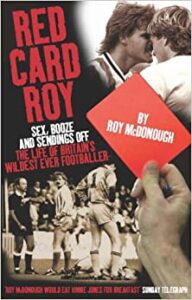
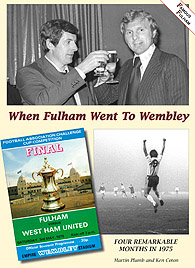
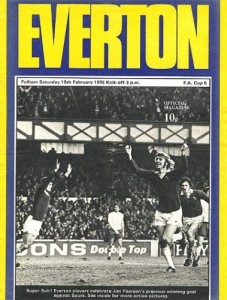
 Cup Final day itself is covered in glorious detail both in words and images, from the players being in the hotel in the morning, the journey to the Wembley, the pre-match build-up and the game itself. Of course, history tells us that there was no fairytale for Mullery and Moore and that feeling of deflation, almost anti-climax, after the game is something I can still remember. The book then closes with typical Ashwater Press attention to detail, as the story of 1975 is placed in context. There are memories from both Martin Plumb and Ken Coton of that incredible four months, as well as David Hamilton. A postscript and epilogue detail how just three years after the Cup Final only Les Strong remained at the club and the part a 20th Anniversary ‘replay’ between Fulham and West Ham had in raising much needed funds during the dark days of the mid-nineties. The ‘Where are they now?’ section is a joy as the reader discovers what happened to those heroes of 1975, but is tinged with sadness as ‘In Memoriam’ reminds us of those no longer with us who were involved in that incredible journey – Chappie D’Amato, Bill Taylor, Tommy Trinder, Bobby Moore, Ted Drake, Alec Stock and Roy Woolnough.
Cup Final day itself is covered in glorious detail both in words and images, from the players being in the hotel in the morning, the journey to the Wembley, the pre-match build-up and the game itself. Of course, history tells us that there was no fairytale for Mullery and Moore and that feeling of deflation, almost anti-climax, after the game is something I can still remember. The book then closes with typical Ashwater Press attention to detail, as the story of 1975 is placed in context. There are memories from both Martin Plumb and Ken Coton of that incredible four months, as well as David Hamilton. A postscript and epilogue detail how just three years after the Cup Final only Les Strong remained at the club and the part a 20th Anniversary ‘replay’ between Fulham and West Ham had in raising much needed funds during the dark days of the mid-nineties. The ‘Where are they now?’ section is a joy as the reader discovers what happened to those heroes of 1975, but is tinged with sadness as ‘In Memoriam’ reminds us of those no longer with us who were involved in that incredible journey – Chappie D’Amato, Bill Taylor, Tommy Trinder, Bobby Moore, Ted Drake, Alec Stock and Roy Woolnough. Growing up in the seventies, my football education came from my dad’s allegiance to The Arsenal and through me discovering my own team, Fulham. The game was a very different beast then. Football on the television consisted of highlights on a Saturday night with ‘Match of the Day’ and Sunday afternoons with ‘The Big Match’. Live football? Well that was one game a season, when the FA Cup Final was shown. Teams wore simple kits in traditional colours without a hint of advertising and played on pitches that varied between sand strewn mud-heaps and bare, rock hard surfaces. It was a time when football was a much more physical game and every First Division team had their ‘hard-man’. Chelsea had Ron Harris, there was Tommy Smith at Liverpool and Norman Hunter at Leeds United, whilst Arsenal had Peter Storey. So in reading “True Storey: My Life and Crimes as a Football Hatchet Man” I knew the footballing background against which the story is set.
Growing up in the seventies, my football education came from my dad’s allegiance to The Arsenal and through me discovering my own team, Fulham. The game was a very different beast then. Football on the television consisted of highlights on a Saturday night with ‘Match of the Day’ and Sunday afternoons with ‘The Big Match’. Live football? Well that was one game a season, when the FA Cup Final was shown. Teams wore simple kits in traditional colours without a hint of advertising and played on pitches that varied between sand strewn mud-heaps and bare, rock hard surfaces. It was a time when football was a much more physical game and every First Division team had their ‘hard-man’. Chelsea had Ron Harris, there was Tommy Smith at Liverpool and Norman Hunter at Leeds United, whilst Arsenal had Peter Storey. So in reading “True Storey: My Life and Crimes as a Football Hatchet Man” I knew the footballing background against which the story is set. In 1968 and 1969 the Gunners made it to Wembley to the League Cup Final. Despite losing both, 1-0 against Leeds United in 1968 and 3-1 against Swindon Town in 1969, the good times at Highbury were about to bloom. In 1969/70 Arsenal took part in the Fairs Cup (now Europa League) and overcame Anderlecht 4-3 over two-legs in the Final. Even better was to come the following season. Given the historic nature of Arsenal doing the Double, Storey does devote two chapters to the achievements of that memorable season for the Gunners. However, it wasn’t all glory, glory as Storey saw it.
In 1968 and 1969 the Gunners made it to Wembley to the League Cup Final. Despite losing both, 1-0 against Leeds United in 1968 and 3-1 against Swindon Town in 1969, the good times at Highbury were about to bloom. In 1969/70 Arsenal took part in the Fairs Cup (now Europa League) and overcame Anderlecht 4-3 over two-legs in the Final. Even better was to come the following season. Given the historic nature of Arsenal doing the Double, Storey does devote two chapters to the achievements of that memorable season for the Gunners. However, it wasn’t all glory, glory as Storey saw it.
 Storey recalls the highs of those events in Chapter Twelve, (“I’ll always have Sheffield”), but Stoke also had unhappy memories later that season when Storey was injured in the fixture against the Potters at Highbury. It meant he missed the title decider at Tottenham and he admits he felt something of an outsider as the team celebrated the title win and observed that he, “…knew a little of the emotional pain and bitter disappointment Jimmy Greaves experienced when he was injured during the World Cup and watched as his replacement Geoff Hurst became a national hero…”. Still carrying the injury, missing the Cup Final looked inevitable and Storey recalls an intriguing episode in which he believes Bertie Mee tried to ensure he missed the game. Peter Storey having declared himself fit was then put through his paces by the manager which Storey saw as an “…unbelievably gruelling fitness test…” However, Storey came through the test, but on the day in the Final against Liverpool he lasted about an hour before limping off.
Storey recalls the highs of those events in Chapter Twelve, (“I’ll always have Sheffield”), but Stoke also had unhappy memories later that season when Storey was injured in the fixture against the Potters at Highbury. It meant he missed the title decider at Tottenham and he admits he felt something of an outsider as the team celebrated the title win and observed that he, “…knew a little of the emotional pain and bitter disappointment Jimmy Greaves experienced when he was injured during the World Cup and watched as his replacement Geoff Hurst became a national hero…”. Still carrying the injury, missing the Cup Final looked inevitable and Storey recalls an intriguing episode in which he believes Bertie Mee tried to ensure he missed the game. Peter Storey having declared himself fit was then put through his paces by the manager which Storey saw as an “…unbelievably gruelling fitness test…” However, Storey came through the test, but on the day in the Final against Liverpool he lasted about an hour before limping off. Success at club level brought Peter Storey international recognition and his first cap came in 1971 in a 3-0 win at Wembley against Greece. Sir Alf Ramsey recognised the versatility of the Arsenal man and in winning 19 caps he played at both right and left back and in midfield for his country. Not bad for somebody who many thought was just an “assassin and a thug…”
Success at club level brought Peter Storey international recognition and his first cap came in 1971 in a 3-0 win at Wembley against Greece. Sir Alf Ramsey recognised the versatility of the Arsenal man and in winning 19 caps he played at both right and left back and in midfield for his country. Not bad for somebody who many thought was just an “assassin and a thug…”